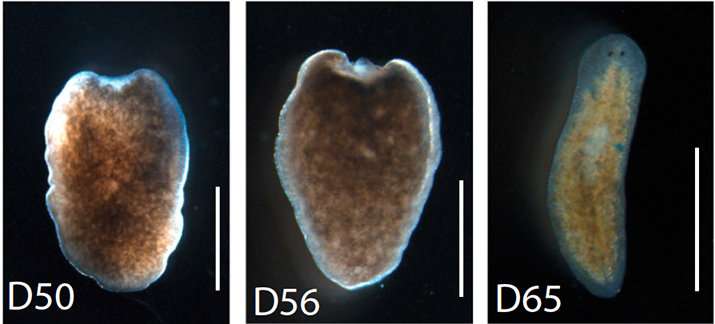Searching for the source of planarians' regenerative powers

Using a technique that involves analyzing thousands of single cells, scientists have figured out a new way to capture a stem cell that underlies flatworm regeneration.
The tiny flatworms Alejandro Sánchez Alvarado studies don't look particularly extraordinary.
They're yellowish brown, with squishy bodies and slightly pointed heads. If you held one in your hand, it would be "about the size of toenail clipping," he says.
But these little worms, called planarians, possess a superpower that's currently unrivaled in the animal kingdom: they can regenerate their entire body – head included – from even a fragment of tail.
In June, Sánchez Alvarado's team reported finding and purifying a cell type that appears to underlie this ability. Transplanting just one of these stem cells into the flatworms helped them recover from an otherwise lethal dose of radiation, the researchers found. Sánchez Alvarado, a Howard Hughes Medical Institute (HHMI) Investigator at the Stowers Institute for Medical Research, and his colleagues described the work in the journal, Cell.
Human adult stem cells aren't nearly as potent. But, Sánchez Alvarado says, isolating and studying the source of planarians' regenerative powers could potentially help scientists supercharge human cells. That might allow our bodies to better repair injured or aging cells, and even fix damage caused by degenerative disease.
"You can imagine using this knowledge to try and coax activity from our own cells – to mitigate some of our maladies," Sánchez Alvarado says. That day is still far down the road. "But you've got to take steps to get there," he says. "This is one of those steps."
Wonder worm
Planarians' simple-looking bodies belie their mysterious skills.
Two brain lobes in the head connect to two nerve cords that travel all the way to the tail tip. Neurons bridge the cords like steps in a ladder. Flatworm nervous systems are actually fairly complex, Sánchez Alvarado says. They contain every kind of neuron that's ever been described.
And yet somehow, if snipped into pieces, flatworms can regenerate all these different cell types. "These animals can be cut into dozens of fragments and each and every one will go on to regenerate a complete animal," he says.
In the late 1800s, scientists traced the source of this regenerative potential to clusters of neoblasts, pluripotent stem cells that can transform into any type of cell in the body. Neoblasts are incredibly abundant in flatworms, Sánchez Alvarado says, but not all neoblasts are alike. Some appear to play a fundamental role in regeneration. Searching for the ones that do is beyond looking for a needle in a haystack, he says, "it's like looking for a needle in a mountain of needles."
Sánchez Alvarado wanted to fish these cells out to study them – but first he had to find them. His team started by identifying cells that made high levels of PIWI-1 protein and RNA, molecules known to be produced by neoblasts. Then, his team genetically analyzed more than 7,000 of these PIWI-1 producers and compared which genes were turned on in all of the different cells.
The researchers used this information to identify groups of similarly behaving cells. One group, nicknamed "NB2," stood out. It appeared to be an uncharacterized type of neoblast, Sánchez Alvarado says. "We hypothesized that maybe, just maybe, the NB2 cell group might contain the pluripotent neoblasts."

Going fishing
Using a kind of molecular hook, the researchers fished NB2 cells from pools of other neoblasts. Then, the team transplanted the cells into living planarians that had been blasted with radiation. Radiation kills neoblasts, which the worms need to replenish old and dying cells. Without neoblasts, planarians typically die within weeks.
But when his team injected a single NB2 cell into the irradiated flatworms, they survived. In fact, Sánchez Alvarado says, "they're still alive today." Roughly a quarter of the NB2 cells his team tested were able to rescue the worms from the radiation hit, the researchers found. That's about a 30-fold increase in rescue efficiency compared with previous efforts, he says.
The results suggest that these stem cells are a key player in regeneration, says stem cell biologist Peter Reddien, an HHMI investigator at the Whitehead Institute for Biomedical Research. Reddien's team also analyzed thousands of neoblasts and identified distinct clusters, work published in the journal Science in April.
Sánchez Alvarado's work offers a new and efficient way for scientists to pull out these powerful stem cells, Reddien says. "Once these cells can be isolated, one can go in and study them further. That's going to help us understand how stem cells are driving regeneration in these animals."
Now, Sánchez Alvarado wants to figure out what, exactly, makes these cells tick. He'd also like to use genetic tricks to light up the cells inside living worms – to watch the cells in action, in real time.
"We've never seen these cells do what they do," he says. "I get excited just talking about it."
More information: An Zeng et al. Prospectively Isolated Tetraspanin + Neoblasts Are Adult Pluripotent Stem Cells Underlying Planaria Regeneration, Cell (2018). DOI: 10.1016/j.cell.2018.05.006
Christopher T. Fincher et al. Cell type transcriptome atlas for the planarian Schmidtea mediterranea, Science (2018). DOI: 10.1126/science.aaq1736
Provided by Howard Hughes Medical Institute



















